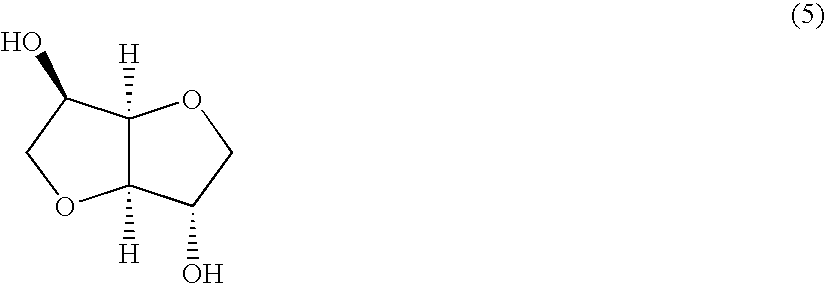Polycarbonate and process for producing the same
a technology of polycarbonate and polycarbonate, which is applied in the field of polycarbonate, can solve the problems of poor moldability of isosorbide-derived polycarbonates, and achieve the effect of excellent heat resistance and moldability
- Summary
- Abstract
- Description
- Claims
- Application Information
AI Technical Summary
Benefits of technology
Problems solved by technology
Method used
Image
Examples
example 1
[0050] Into a reactor were charged 29.23 parts by weight of isosorbide, 1.51 parts by weight of ethylene glycol and 49.48 parts by weight of diphenyl carbonate, and further 2×10−3 parts by weight of tetramethylammonium hydroxide (1×10−4 mol of this compound to 1 mol of the diol component) and 30×10−4 parts by weight of 2,2-bis(4-hydroxyphenyl)propane disodium salt (0.5×10−6 mol of this compound to 1 mol of the diol component), and they were melted at 180° C. under a nitrogen atmosphere.
[0051] The reaction was carried out for 20 minutes under stirring while the formed phenol was distilled away by reducing the inside pressure of the reactor to 13.3×10−3 MPa. Subsequently, after the temperature was raised to 200° C., the pressure was reduced gradually, and the reaction was carried out for 25 minutes at 4.00×10−3 MPa while phenol was distilled away. Further, the reaction was carried out for 10 minutes after the temperature was raised to 215° C.
[0052] Subsequently, the pressure was gra...
examples 2 to 5
[0054] Isosorbide, ethylene glycol and diphenyl carbonate having amounts shown in Table 1 were charged into a reactor. As polymerization catalysts, tetramethylammonium hydroxide and 2,2-bis(4-hydroxyphenyl)propane disodium salt were charged at the same ratios of concentrations as Example 1, they were melted at 180° C. under a nitrogen atmosphere, and polymerization reaction was carried out in the same manner as Example 1 to obtain a polymer. The reduced viscosity and glass transition temperature of the polymer are shown in Table 1.
example 6 to 8
[0055] Isosorbide, 1,3-propanediol and diphenyl carbonate having amounts shown in Table 1 were charged into a reactor. As polymerization catalysts, tetramethylammonium hydroxide and 2,2-bis(4-hydroxyphenyl)propane disodium salt were charged at the same ratios of concentrations as Example 1, and they were melted at 180° C. under a nitrogen atmosphere.
[0056] Polymerization reaction was carried out in the same manner as Example 1 to obtain a polymer. The reduced viscosity and glass transition temperature of the polymer are shown in Table 1.
[0057] By using the polymer obtained in Example 6, a dumbbell-shaped molded piece, that is, a tabular molded piece of 120 mm×12 mm×3 mm was produced, and the moldability was evaluated. The results are shown in Table 3.
[0058] A film was produced from the polymer obtained in Example 6, and the biodegradability was evaluated. The reduction in weight of the test piece was 15.9%.
PUM
| Property | Measurement | Unit |
|---|---|---|
| glass transition temperature | aaaaa | aaaaa |
| wt. % | aaaaa | aaaaa |
| temperature | aaaaa | aaaaa |
Abstract
Description
Claims
Application Information
 Login to View More
Login to View More - R&D
- Intellectual Property
- Life Sciences
- Materials
- Tech Scout
- Unparalleled Data Quality
- Higher Quality Content
- 60% Fewer Hallucinations
Browse by: Latest US Patents, China's latest patents, Technical Efficacy Thesaurus, Application Domain, Technology Topic, Popular Technical Reports.
© 2025 PatSnap. All rights reserved.Legal|Privacy policy|Modern Slavery Act Transparency Statement|Sitemap|About US| Contact US: help@patsnap.com



